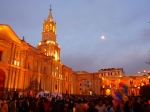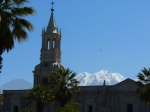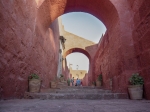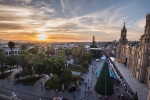Information about Arequipa
Arequipa is the third most populous city in Peru after Lima and Trujillo, 2014 reaching 1,259,800 inhabitants according to the projections. Arequipa is an important industrial and commercial center of Peru and thanks to its remarkable industrial activity is ranked as the second most industrialized city in the country.
Within its industrial activity highlights the manufactured products and textile production camel wool export quality; so the city maintains close commercial ties with Chile, Bolivia and Brazil; links with cities connected by the Southern Railway and the port of Matarani.
In the republican history of Peru city acquires greater role in the political field, with focus of popular, civic and democratic rebellions, and was also the birthplace of outstanding intellectual figures, political and religious country. In the Republican era is granted the title of "Heroic City of Arequipa free."
Its historic center is spread over an area of ??332 hectares and was declared by UNESCO as "Cultural Heritage", the historic and monumental heritage and its diverse scenic and cultural sites makes it a city receiving national tourism and international in its historic highlights the colonial and republican product mix European and native characteristics religious architecture, which constituted an own stylistic school called "Arequipa School" of crucial importance in the region and whose influence came to Potosi (Bolivia) .
There are two theories about the origin of the name Arequipa. Long ago the Aymara founded a colony here. In the Aymara language, "ARI" arises from "top" and "QUIPA" by "lying behind". Actually, this majestic volcano "El Misti" can be seen from Arequipa.
A second theory is that the name comes from the language of the Incas, Quechua. Legend has it that Mayta Capac, the fourth Inca, traveled through the valley. A column of soldiers, sacred virgins and nobles escorted the Inca. Mayta Capac saw the settlement that has never been visited by any emperor and I am so amazed by its beauty and strategic importance as a link between the ocean and Cusco, in the middle of the Andes, he said: "Ari, quipay" translated as "Yes, there is." Given the desire of the Inca, some members of his entourage settled on this place to develop the area as an important city for the Inca Empire.
The Spanish founded the city on 15 August 1540. This date is still remembered with parties inside and outside of Arequipa with carnivals and fairs night for a week. The festive climax is the August 14 with fireworks at the Plaza de Armas.
El Misti (the gentleman) is not the only volcano near Arequipa, but the most famous and elegant, in the middle are two smaller, Chachani (Beloved) and the steep Picchu Picchu (The peak top).
The pressure between the tectonic plates of Latin America and the Pacific created some memorable dates in Arequipa. In 1687 and 1868 earthquakes destroyed most of the buildings in the city. Well as the Cathedral and the church of San Francisco they were damaged. Many of the churches date back to 1868. The reconstruction ended in 1898. The cathedral is why this looks pretty cool compared to other cathedrals in Peru. In its external Cathedral shows an impressive baroque style.





